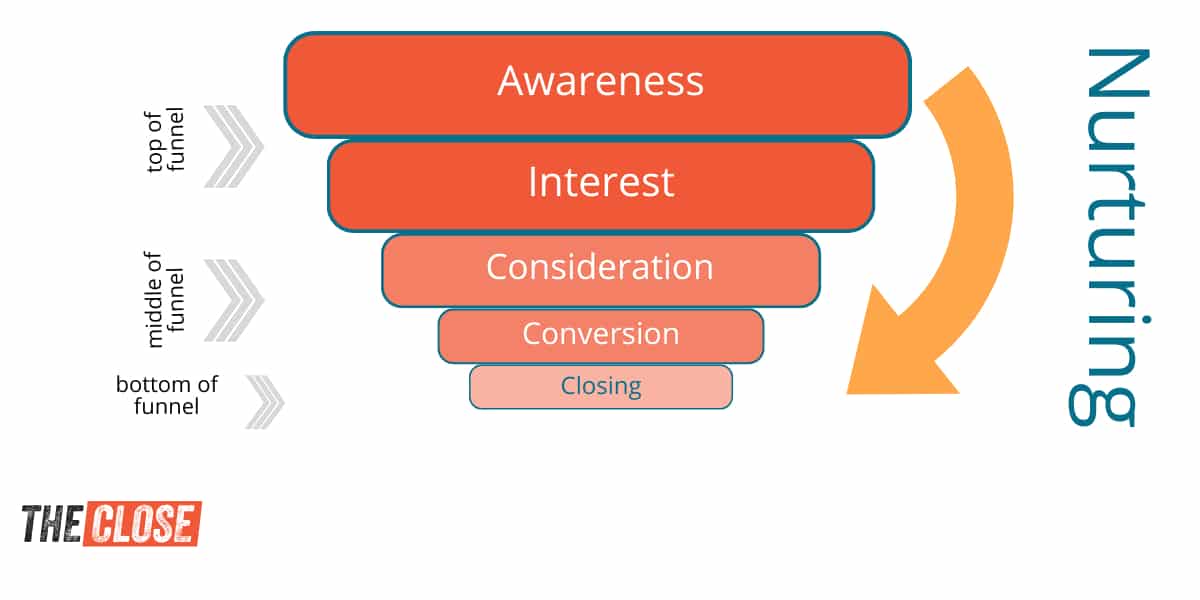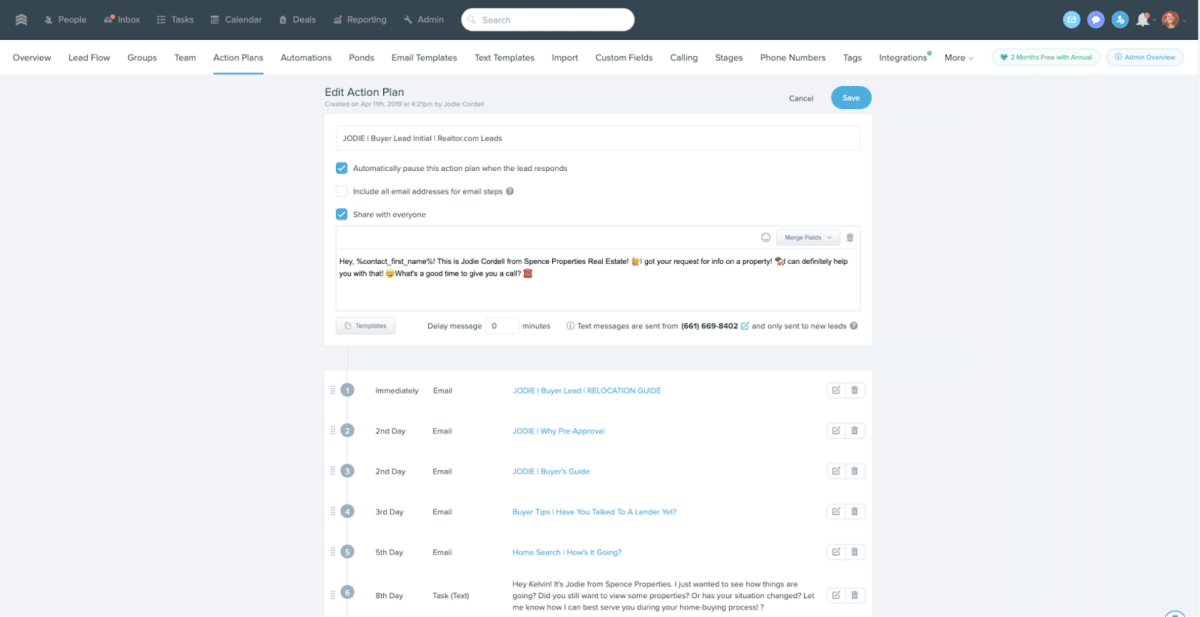So you’ve captured some leads and built your database—now what? Sometimes securing leads is the easy part while converting them to sales is where the work really begins. Time and patience are your best friends when it comes to real estate lead nurturing. That’s why I’ve put together seven simple strategies to help you convert leads and boost your business.
What Is Lead Nurturing?
When considering how to nurture real estate leads, think of it as relationship building. While you will use a strategy akin to a sales funnel, leading a prospect from capture to close, you are also forming a genuine connection that will hopefully create a long-lasting relationship and yield referral business.
The goal of lead nurturing is to be the agent who your leads call when they’re ready to make a move. This is where your patience pays off and results from the genuine foundation on which your relationship was built.
- Awareness: In this initial stage, leads just learn about your services. They seek information, resources, and education but may not know much about you and your business. They will review your real estate website, search online, and check out your social media profiles.
- Interest: The next step is when a lead shows interest in working with you. They may call you or attend your open house. Your goal at this point is to build a relationship with the lead and address any questions they may have.
- Consideration: Once leads know their needs, they research possible solutions. If they’re a seller lead, they’ll consider if you’ve sold properties similar to theirs and how many listings you have. During this stage, they actively look for options, compare features and costs, and try to find the best fit for their needs.
- Conversion: You’ve been waiting for this stage—you’ve converted the lead into a client! At this point, you will have your new client sign the necessary representation paperwork.
- Closing: The final stage is when you start actively working directly with your client to help them reach their real estate goals.

The idea of nurturing your leads for months, or even years, may seem tedious. However, tracking the progress of each lead and understanding where they are in the funnel will help you stay efficient and consistent. Starting from the ‘awareness’ stage, right at the top of the funnel, your strategic approach will propel every lead towards the ‘closing’ stage in no time.
Real Estate Lead Nurturing Strategies & Tools
Now that you’ve set your systems and processes in place, it’s time to take the next step and start building connections with potential clients. With these seven easy steps and helpful scripts, you’ll not only bring in more leads but also improve your conversion skills.
Tip 1: Make Sure Your Database Is in Your CRM
Transferring all your leads and clients to a CRM is a great way to ensure you’re on top of all your outreach and communication efforts. With a full real estate CRM, you’ll have all your info and data at your fingertips whenever needed. Create a personalized system that suits you best. However, automating the transfer of leads from text or email directly into the CRM will save you time and effort and help you create a streamlined nurturing system. Here’s what a CRM will do for you:
- Lead capture system: Create a pipeline in your CRM to segment and organize your leads so you know where they are in the sales funnel. There are many real estate lead generation platforms from which to choose.
- Outreach and follow-up process: Once you have the leads in your database, you’ll need a system for reaching out to them as soon as possible. Automate these drip campaigns through your CRM to provide a series of follow-ups that build trust, provide value, and encourage your database to reach out to you for your services.
- Prioritize leads likely to convert: Based on user activity and responses, CRMs will help you prioritize the leads with the most opportunity. Some CRMs come with predictive analytics that shows the likelihood of sellers who may be ready to list their homes.

Want a system that does all the above tasks? Check out Top Producer! It is an efficient CRM with high-level functionality and many options for lead gen and nurturing. Their social advertising function sends leads directly to your Top Producer CRM, where the automated nurturing system kicks in, increasing your conversion rate.
Grow your database with a steady stream of affordable, exclusive real estate leads from social media ads. Social Connect from Top Producer is designed to get you a high volume of leads and move them through your pipeline until they’re ready to buy and sell real estate. Connect with an average of 30 consumers interested in real estate in your local market for just $300 per month!
How Social Connect works:
Tip 2: Utilize Your Phone to Make Calls Or Send Texts
While methods of communication have changed over the years, there is still value in a good old-fashioned phone call. When you receive a lead, call the lead as soon as you can. If you need help starting a conversation, practice with phone scripts before you start taking leads so you will be prepared with questions.
If you can’t get through, send a text message as a follow-up to the phone call, as some people may initially prefer to communicate that way. Phone call check-ins should also be a regular part of your follow-up process, as this helps build the relationship.
Pro Tip: Remember to stay up-to-date on the do-not-call list. If a lead is not on the list, always respect their wishes if they request that you stop contacting them.
Tip 3: Set Up Drip Campaigns

When you’re sending emails, it’s great to keep things interesting for your recipients. Mix it up with four to 10 different targeted emails in your campaigns, strategically spaced out over several days or weeks. It’s all about finding that sweet spot where you stay top of mind without overwhelming anyone.
-
Email 1 (Day 1): Introduction email to you and your services/newsletter
-
Email 2 (Day 3): Listings in the area that have sold in the last three months, stats about how quickly and how much these were sold for
-
Email 3 (Day 6): Informational packet for sellers
-
Email 4 (Day 8): Send link to receive a free home valuation report
-
Email 5 (Day 11): Show examples of homes sold and marketing tactics that contributed
The key to a solid drip campaign is to remember your goal: to create a lasting relationship that nurtures your leads over time. Your emails should lead to a call to action (CTA), such as an in-person meeting.
Tip 4: Create Monthly Newsletters
Another great way to engage with your leads, showcase your expertise, and build trust is by sending out a monthly newsletter. While drip campaigns are geared towards driving sales, newsletters focus on offering valuable insights and allowing recipients to get to know you and your business more deeply.

Use a site like Coffee & Contracts to schedule newsletters in advance and save time. Coordinate your content with seasons and holidays, and don’t forget to include community news for the areas you serve. It’s a great way to keep everyone in the loop and build stronger connections.
Tip 5: Engage on Social Media

Staying in touch through social media is super important these days. Engage with your prospects on social platforms instead of just using emails, calls, and texts. Comment on prospects’ posts, send a relevant article, or even tag them in posts about great new spots in town. Keep the conversation going, and I bet you’ll start to see those friends on social media turn into clients and referrals.
Tip 6: Send Direct Mail
Before the days of phone calls, there were—you guessed it—letters in the mail. Although times have changed, direct mail shouldn’t be overlooked. It’s still a tried and true method of connecting and nurturing leads. Send out postcards, flyers, and even a quarterly recipe. Take it further and send handwritten notes to warm leads further down the funnel.

Example of an AI-generated handwritten postcard (Source: Ballpoint Marketing)
Signing up to work with a direct mail company allows you to set up a seamless mailing campaign. With a company like ProspectsPLUS!, you can select from various direct mailers, including postcards, flyers, brochures, and door hangers. You also have the option to schedule your campaigns for the entire year, ensuring that you remain top of mind and provide valuable information.
Tip 7: Host Events
A key element to an effective lead nurturing strategy is to connect face-to-face. When leads have the chance to meet you in person, they are much more likely to feel comfortable and confident in choosing your services. Organize an event to provide them with this opportunity. Host a class on the home buying process, throw a client appreciation event, or hold an annual holiday party. I’ve also invited leads to one of my open houses as a way to meet in person and showcase my expertise.
Best Practices for Lead Nurturing
By incorporating these lead nurturing best practices into your approach, you’ll have the opportunity to show off your unique style as an agent and how you get things done. Creating your own systems for your personal business is a great way to distinguish yourself from other agents.
- Follow-up with leads promptly
- Stay organized by categorizing your leads
- Personalize your communication
- Use multi-channel outreach
- Create targeted campaigns
- Always provide valuable content
- Practice patience
- Use active listening to connect with leads
- Tap into your customer service skills
- Practice time management
- Use past testimonials to build trust
- Have confidence in your skills
- Automate some of your outreach
- Set pace and timeframe for outreach
Frequently Asked Questions (FAQs)
How do real estate agents get leads?
There are many ways to generate real estate leads, and it’s important to have multiple lead sources. Real estate prospecting includes tapping into your sphere of influence, purchasing leads, leaving business cards in local establishments, social media advertising, circle prospecting or farm mailing, open houses, and generating referrals, to name a few.
How important is lead generation in real estate?
How to generate leads in real estate is one thing; turning them into clients is what really counts. Without converting leads into clients, we don’t make any money. So this is a key factor in growing a sustainable real estate business. Fine-tune your lead gen and conversion processes to ensure a steady flow of clients and income.
What is the ROI of lead nurturing?
Nurturing leads will automatically create a higher return on investment (ROI) than leads that are not nurtured. In fact, according to The Online Marketing Institute, companies that nurture their leads experience a 45% increase in lead generation ROI. This is because when you nurture leads, you start to form a relationship and build trust.
Bringing It All Together
Lead nurturing in real estate is much like everything else—best when practiced authentically. When you put together a thoughtful nurturing campaign, with the help of your CRM, and begin a warm, lasting relationship, there is more of a chance of turning that lead into a happy client. Have any tips or strategies on how to nurture real estate leads and convert them? Leave us a comment below!











